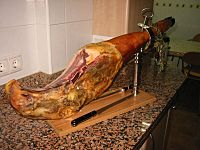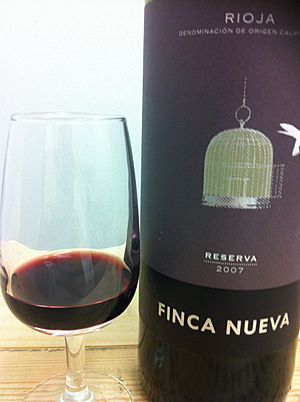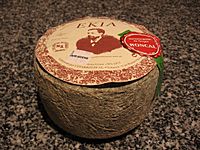Denominación de origen facts for kids
The denominación de origen (say: deh-noh-mee-nah-SYOHN deh oh-REE-hen), often called DO, is a special system in Spain. It helps make sure that certain foods and drinks are of high quality and come from a specific place. Think of it like a special label that tells you a product is authentic and made in a traditional way. This system is used for things like cheeses, honey, meats, and especially wines.
Spain's system is similar to those in France and Italy. It makes sure that only products from certain areas, made with specific methods, can use the DO name. This helps protect the quality and reputation of Spain's best foods and drinks. The European Union (EU) also recognizes many of these Spanish DOs. Other countries, especially in Latin America, have started using similar systems too.
Contents
What is a Denominación de Origen?
The Spanish Ministry of Agriculture, Fisheries and Food helps control the quality of Spanish foods. They use a special label system, and the denominación de origen is for the highest quality products.
For each DO region and food type, there's a special group called a Consejo Regulador. These groups are made of experts who check the quality, ingredients, and how each product is made. They make sure everything meets high standards. They also make sure that the products come from the correct geographical area.
Products with a denominación de origen label are known for their excellent quality. They also have special features because of where they come from or how a specific producer makes them. A key rule for a DO label is that no product made outside that specific region can use the DO name.
History of the DO System
Food and wine have always been very important in Spanish culture. People have tried to set rules for them for hundreds of years. It wasn't until the 1600s that laws started to appear for wine. These laws first tried to stop, then encourage, and finally control how wine was made, sold, and used. Rules for food took even longer to develop. They became more common when Spain joined the European Union (EU) in the late 1900s.
In the 1920s, Spain started to create a classification system similar to France's. The Rioja region became the first Spanish denominación in 1925. Then, in 1932, the "Wine Statute" was created, and the sherry-making region of Jerez also gained national and international recognition.
Over time, new laws were needed because farming technology changed a lot. When Spain joined the European Community in 1986, it had to quickly update its food and wine classifications to match other EU countries.
Finally, in 1996, the Spanish government created its own detailed quality levels. These levels fit with EU rules but were also specific to Spanish farming. For example, the EU has a category called "Quality Wines Produced in Specified Regions" (QWPSR). The Spanish denominación de origen is a part of this QWPSR system. This has helped improve the quality of Spanish products, and many people praise the system.
Types of Products with DO Status
Denominaciones de origen status can be given to many different foods and condiments. These include:
- Olive oil
- Rice
- Bread, cakes, and pastries
- Cheese and butter
- Fresh meat
- Prepared meats and sausages
- Cured ham
- Fish, molluscs, and crustaceans
- Vegetables
- Fruit
- Honey
- Condiments and spices
- Cider
- Wine
- Distilled alcoholic drinks
The denominación de origen label means a product is of top quality, has clear characteristics, uses specific ingredients, and comes from a known and checked source. Other quality labels, which can sometimes overlap, include:
- Denominación de origen protegida (DOP): This is an EU label for food products that are special to a certain region or town. Their quality or features come directly from that area.
- Indicación geográfica protegida (IGP): Similar to DOP, but for a larger or less specific geographical area.
- Especialidades tradicionales Garantizadas (ETG): For products made using traditional ingredients, recipes, or methods.
- Producción agricultura ecológica (PAE): This is an organic food label for products made using natural, environmentally friendly farming methods.
By 2004, Spain had 250 denominaciones de origen and indicaciones geográficas protegidas. More than half of these were for food products. Here are some well-known examples:
Olive Oil

Some olive oils with denominaciones de origen include:
- Aceite Monterrubio: From Badajoz in Extremadura.
- Baena: From the south-east of Cordoba.
- Les Garrigues: From Lleida in Catalonia.
- Priego de Córdoba: From Cordoba.
- Sierra Magina: From the southern part of Jaén province.
- Sierra Segura: From the north-east of Jaén province.
- Siurana: From Tarragona.
Iberian Ham (jamón ibérico)

The famous jamón ibérico (Iberian ham) has several denominaciones de origen, such as:
- Huelva: Known for jamón de Jabugo.
- Teruel
- Guijuelo: Famous for hams from acorn-fed pigs.
- Dehesa de Extremadura
- Los Pedroches
Cheese
Some Spanish cheeses with DO status are:
- Tetilla: An unusually shaped cheese from Galicia.
- Cabrales: A blue cheese from Asturias.
- Picon Bejes-Tresviso: From the Liébana region in Cantabria.
- Idiazábal: A Basque cheese.
- Roncal: From Navarre.
- Zamorano: From Zamora.
- Manchego: From La Mancha.
- Torta del Casar: A sheep-milk cheese from Cáceres.
Vinegar
Spain has three of the four protected vinegars in the EU:
- Vinagre de Jerez: Sherry vinegar from Jerez.
- Condado de Huelva: White wine vinegar from Huelva.
- Montilla-Moriles
Wine
The way wine regions are classified in Spain can seem a bit complicated. The denominación de origen (DO) is a main category, similar to France's AOC or Italy's DOC.
As of 2019, Spain has 138 wine regions with some kind of geographical classification. The Spanish DO is part of a larger EU system called QWPSR (Quality Wine Produced in Specific Regions). Spain adopted this system in 1986.
Here's how Spanish wine categories are organized:
- DOP – denominación de origen protegida ('protected denomination of origin'): This is the main system for controlling wine quality in Spain. Each region has a consejo regulador that sets rules for the area, grape types, how much wine can be made, and other quality standards. There are 96 DOPs, which include the categories below.
- DOCa – denominación de origen calificada ('denomination of qualified origin'): This is the highest category for Spanish wines. It's for regions with very high grape prices and strict quality checks. Rioja was the first to get this status in 1991, followed by Priorat in 2003. Priorat uses the Catalan name DOQ. These two are considered "above" regular DO status.
- DO – denominación de origen: This is the most common quality control system for Spanish wines.
- VP – vino de pago ('estate wine'): This is a special category for high-quality wines from a single vineyard estate.
- VC – vino de Calidad con indicación geográfica ('quality wine with geographic indication'): This category is for wines that are good quality but don't quite meet the strict DO standards.
- IGP – indicación geográfica protegida (PGI, 'protected geographical indication'): This is part of the EU's PGI system. It's for wines from a specific place that have a certain quality or reputation because of their origin. These can also be called Vino de la Tierra (VT).
- VdM – vino de mesa ('table wine'): This is the basic category for all wines that don't fit into the other classifications. It includes everyday wines and sometimes even expensive wines that are made in new, untraditional ways.
The two top DOCa/DOQ regions are Priorat (Tarragona) and Rioja.
Some other well-known DO wine regions include:
- Campo de Borja (Zaragoza): Known for Garnacha and Tempranillo wines.
- Málaga and Sierras de Málaga (Málaga): Traditionally known for sweet and fortified wines.
- Montilla – Moriles (Córdoba): Produces sweet dessert wines similar to sherry.
- Navarra (Navarre): Once known mostly for rosé wines, now also makes quality reds and whites.
- Penedès (Barcelona): Famous for the sparkling wine Cava, and red wines.
- Rías Baixas (Galicia): Known for its Albarino white wines, which are very popular.
- Ribera del Duero (Castile and León): Challenges Rioja for the most popular red wines in Spain, mostly made from the Tempranillo grape.
- Rueda (Castile and León): Produces reds and whites, often less expensive than its famous neighbors.
- Jerez (Xérès) (Cádiz): The origin of the English word "sherry," a fortified wine that can be dry or sweet.
- Toro (Castile and León): Produces red wines like Tinta de Toro, which is a local name for Tempranillo.
Sherry / Jerez
The Jerez-Xérès-Sherry DO in Spain uses special categories for sherry:
- VOS – This means "very old sherry" and applies to sherries that are at least 20 years old on average.
- VORS – This means "very old rare sherry" and applies to sherries that are at least 30 years old on average.
See also
 In Spanish: Denominación de Origen para niños
In Spanish: Denominación de Origen para niños




